The Impact of Solar Power Plants on the Electricity Grid: A Case Study of Albania
Abstract
:1. Introduction
2. The Current Landscape of Solar Energy Development in Albania
3. Data on Solar Plants Installed in the Electric Power System in Fieri Region
4. Analysis of the Power System During Energy Penetration from Solar Power Plant Production
- •
- Scenario 1—50% of solar plant capacity, system load at 70% of maximum value.
- •
- Scenario 2—50% of solar plant capacity, system load at maximum value.
- •
- Scenario 3—100% of solar plant capacity, system load at 70% of maximum value
- •
- Scenario 4—100% of solar plant capacity, system load at maximum value.
4.1. Scenario 1—50% of Solar Plant Capacity, System Load at 70% of Maximum Value
4.2. Scenario 2—50% of Solar Plant Capacity, System Load at Maximum Value
4.3. Scenario 3—100% of Solar Plant Capacity, System Load at 70% of Maximum Value
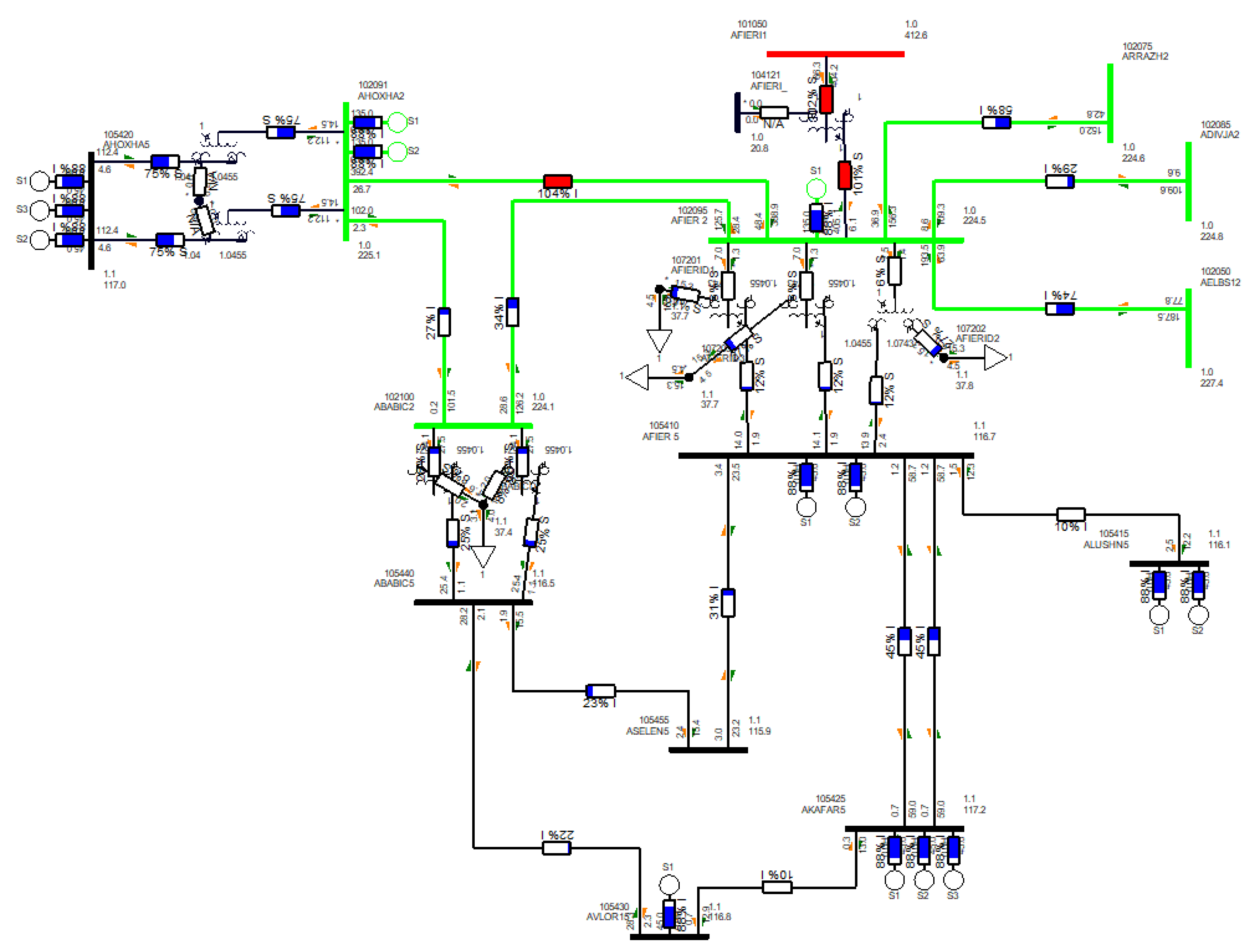

4.4. Scenario 4—100% of Solar Plant Capacity, System Load at Maximum Value
5. Summary and Conclusions
- •
- Strengthening interconnection lines: Given that the load on the electrical system is expected to increase moderately based on statistical data, simply absorbing additional generation from solar plants is insufficient. Enhancing interconnection lines will be necessary to export the excess energy produced.
- •
- Managing voltage levels: In addition to installing reactors at key nodes in the electrical system, solar plants should contribute to voltage regulation in accordance with the transmission code to ensure system stability.
- •
- Involving private sector investments: Increasing transmission capacities in specific regions with high solar resource potential, through private sector involvement, will be crucial for enhancing the grid’s ability to accommodate solar energy generation.
- •
- Upgrading transformer capacity: Static analysis of the electrical network in scenarios with significant solar penetration indicates a need to increase transformer capacities at local substations. Moreover, the creation of a new transformation node at the 400 kV level may also be required to support the increased generation.
- •
- Energy storage systems: Balancing grid supply and demand can be achieved through the use of energy storage technologies. Excess solar energy can be stored in batteries during periods of high generation and utilized when needed to smooth out fluctuations in power supply.
Author Contributions
Funding
Institutional Review Board Statement
Informed Consent Statement
Data Availability Statement
Conflicts of Interest
References
- Author Energy Regulator Authority, Annual Report 2023. Available online: https://www.ere.gov.al/media/files/2024/10/01/Anual_Report_2023.pdf (accessed on 10 December 2024).
- Kojinović, D.; Petrović, M. Energy transition in the Balkans: The case of hydropower dependence. Energy Rep. 2019, 5, 438–444. [Google Scholar]
- Bebi, E.; Stermasi, A.; Alcani, M.; Cenameri, M. Assessment of Wind Potential: The Case of Puka Region in Albania. Int. J. Innov. Technol. Interdiscip. Sci. 2023, 6, 1112–1120. [Google Scholar]
- Smajić, D.; Kolić, M. Energy infrastructure in the Western Balkans: Challenges and opportunities. Energy Policy 2020, 138, 111213. [Google Scholar]
- Dorri, A.; Alcani, M.; Gjeta, A. The Role of the Agriculture and Forestry Sectors in Greenhouse Gas Emission: The Case of Albania. J. Integr. Eng. Appl. Sci. 2023, 1, 32–39. [Google Scholar]
- Tosheva, A.; Christoskov, I. Energy security and diversification in Southeast Europe: Lessons from the Balkans. J. Energy Secur. 2018, 12, 22–31. [Google Scholar]
- European Commission. Energy System Integration in the Western Balkans: A strategy for a Sustainable Future. EU Energy Policy Report. Available online: https://energy.ec.europa.eu/topics/energy-systems-integration/energy-system-integration_en (accessed on 10 December 2024).
- Solar Power Europe. Global Solar Energy Market Outlook, 2017–2021. Available online: https://resources.solarbusinesshub.com/images/reports/172.pdf (accessed on 10 December 2024).
- Lanzini, P.; Morandi, D. The future of energy in Italy: From fossil fuels to renewable integration. Renew. Energy 2019, 140, 27–34. [Google Scholar]
- Fuchs, A.; Lohmann, A.; Gebremedhin, A. Transitioning Towards a Sustainable Energy System: A Case Study of Baden-Württemberg. Int. J. Innov. Technol. Interdiscip. Sci. 2024, 7, 157–197. [Google Scholar]
- Sara, E.; Vijay, V.; Gerald, H.; Brian, K.; Jeffrey, L. Impact of Increasing Penetration of Solar Generation on Power Systems. IEEE Trans. Power Syst. 2013, 28, 893–901. [Google Scholar]
- Papageorgiou, A.; Apostolopoulos, P. Renewable energy sources and energy efficiency in Greece: Challenges and opportunities. Renew. Sustain. Energy Rev. 2017, 77, 1332–1340. [Google Scholar]
- Ramos, A.; Rodríguez, M. Energy transition in Spain: Policies, challenges, and the role of renewables. Energy Policy 2020, 142, 111520. [Google Scholar]
- Dhoska, K.; Bebi, E.; Markja, I.; Milo, P.; Sita, E.; Qosja, S. Modelling the wind potential energy for metallurgical sector in Albania. Sci. Rep. 2024, 14, 1302. [Google Scholar] [CrossRef]
- Baballëku, M.; Verzivolli, A.; Luka, R.; Zgjanolli, R. Fundamental Basic Wind Speed in Albania: An Adoption in Accordance with Eurocodes. J. Trans. Syst. Eng. 2023, 1, 56–72. [Google Scholar]
- Alirezaei, M.; Noori, M.; Tatari, O. Achieving the net zero energy building: Investigating the role of home automation technology. Energy Build. 2016, 130, 465–476. [Google Scholar] [CrossRef]
- Eltawil, M.A.; Zhao, Z. Grid-connected photovoltaic power systems: Technical and potential problems—A review. Renew. Sustain. Energy Rev. 2010, 14, 112–129. [Google Scholar] [CrossRef]
- Benöhr, M.; Gebremedhin, A. Photovoltaic systems for road networks. Int. J. Innov. Technol. Interdiscip. Sci. 2021, 4, 672–684. [Google Scholar]
- Nazir, G.; Rehman, A.; Hussain, S.; Aftab, S.; Patil, S.A.; Aslam, M.; Hafez, A.A.A.; Kwang, H. Bifacial perovskite thin film solar cells: Pioneering the next frontier in solar energy. Nano Energy 2025, 134, 110523. [Google Scholar] [CrossRef]
- Dhoska, K.; Spaho, E.; Sinani, U. Fabrication of Black Silicon Antireflection Coatings to Enhance Light Harvesting in Photovoltaics. Eng 2024, 5, 3358–3380. [Google Scholar] [CrossRef]
- Kumba, K.; Upender, P.; Buduma, P.; Sarkar, M.; Simon, S.P.; Gundu, V. Solar tracking systems: Advancements, challenges, and future directions: A review. Energy Rep. 2024, 12, 3566–3583. [Google Scholar] [CrossRef]
- Khosal, S.; De, D.; Kar Ray, D.; Roy, T. Condition Monitoring of Fixed and Dual Axis Tracker using Curve Fitting Technique. Int. J. Innov. Technol. Interdiscip. Sci. 2023, 6, 1264–1272. [Google Scholar]
- Koysuren, O.; Dhoska, K.; Koysuren, H.N.; Markja, I.; Yaglikci, S.; Tuncel, B. SiO2/WO3/ZnO based self-cleaning coatings for solar cells. J. Sol-Gel Sci. Technol. 2024, 110, 183–203. [Google Scholar] [CrossRef]
- Đurašković, J.; Konatar, M.; Radović, M. Renewable energy in the Western Balkans: Policies, developments and perspectives. Energy Rep. 2021, 7, 481–490. [Google Scholar] [CrossRef]
- Topalović, Z.; Haas, R. Role of Renewables in Energy Storage Economic Viability in the Western Balkans. Energies 2024, 17, 955. [Google Scholar] [CrossRef]
- Ahsan, S.M.; Khan, H.A.; Hussain, A.; Tariq, S.; Zaffar, N.A. Harmonic analysis of grid-connected solar PV systems with nonlinear household loads on low-voltage distribution networks. Sustainability 2021, 13, 13073709. [Google Scholar] [CrossRef]
- Cupelli, M.; Doig Cardet, C.; Monti, A. Voltage stability indices comparison on the IEEE-39 bus system using RTDS. In Proceedings of the 2012 IEEE International Conference on Power System Technology (POWERCON), Auckland, New Zealand, 30 October–2 November 2012. [Google Scholar]
- Walling, R.A.; Saint, R.; Dugan, R.C.; Burke, J.; Kojovic, L.A. Summary of the impact of distributed resources on power distribution systems. IEEE Trans. Power Delivery. 2008, 23, 1636–1644. [Google Scholar] [CrossRef]
- Hao, K.; Achanta, S.; Rowland, B.; Kivi, A. Mitigating the Impacts of Solars on the Power System. In Proceedings of the Power and Energy Automation Conference, Spokane, WA, USA, 21–23 March 2017. [Google Scholar]
- Marik, G.; Dutta, A. A Sustainable Evolution of Indian Railway. J. Trans. Syst. Eng. 2023, 1, 131–139. [Google Scholar]
- International Renewable Energy Agency: Albania’s Renewable Energy Sector. Available online: https://www.irena.org (accessed on 10 December 2024).
- Badran, O.O.; Mamlook, R.; Abdulhadi, E. Toward clean environment: Evaluation of solar electric power technologies using fuzzy logic. Clean Technol. Environ. Policy 2012, 14, 357–367. [Google Scholar] [CrossRef]
- Gebremedhin, A.; Zhuri, M. Power system analysis: The case of Albania. Int. J. Innov. Technol. Interdiscip. Sci. 2020, 3, 501–512. [Google Scholar]
- Zhang, Y.; Ma, C.; Lian, J.; Pang, X.; Qiao, Y.; Chaima, E. Optimal solar capacity of large-scale hydro-solar complementary systems considering power supply requirements and reservoir characteristics. Energy Converters. J. 2019, 195, 597–608. [Google Scholar] [CrossRef]
- Salama, H.S.; Kotb, K.M.; Vokony, I.; Dán, A. The Role of Hybrid Battery–SMES Energy Storage in Enriching the Permanence of PV–Wind DC Microgrids: A Case Study. Eng 2022, 3, 207–223. [Google Scholar] [CrossRef]
- Wang, H.; Wang, J.; Piao, Z.; Meng, X.; Sun, C.; Yuan, G.; Zhu, S. Optimal allocation and operation of an energy storage system with high-penetration grid-connected solar systems. Sustainability 2020, 12, 6154. [Google Scholar] [CrossRef]
- Armenta-Déu, C.; Sancho, L. Sustainable Charging Stations for Electric Vehicles. Eng 2024, 5, 3115–3136. [Google Scholar] [CrossRef]
- Albanian Transmission Code. Available online: https://www.ere.gov.al/doc/Transmission_Network_Code_14.06.2018.pdf (accessed on 10 December 2024).
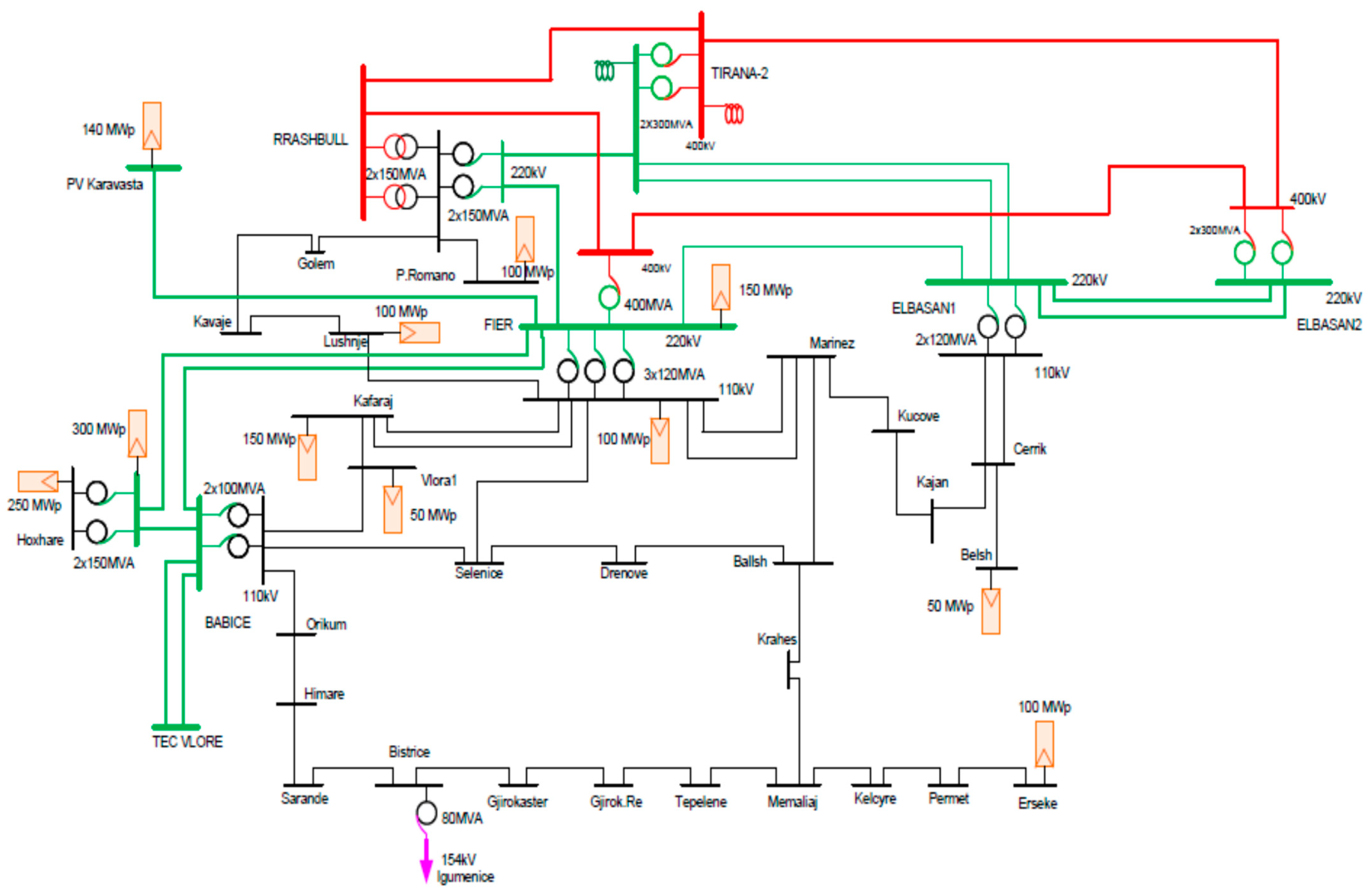

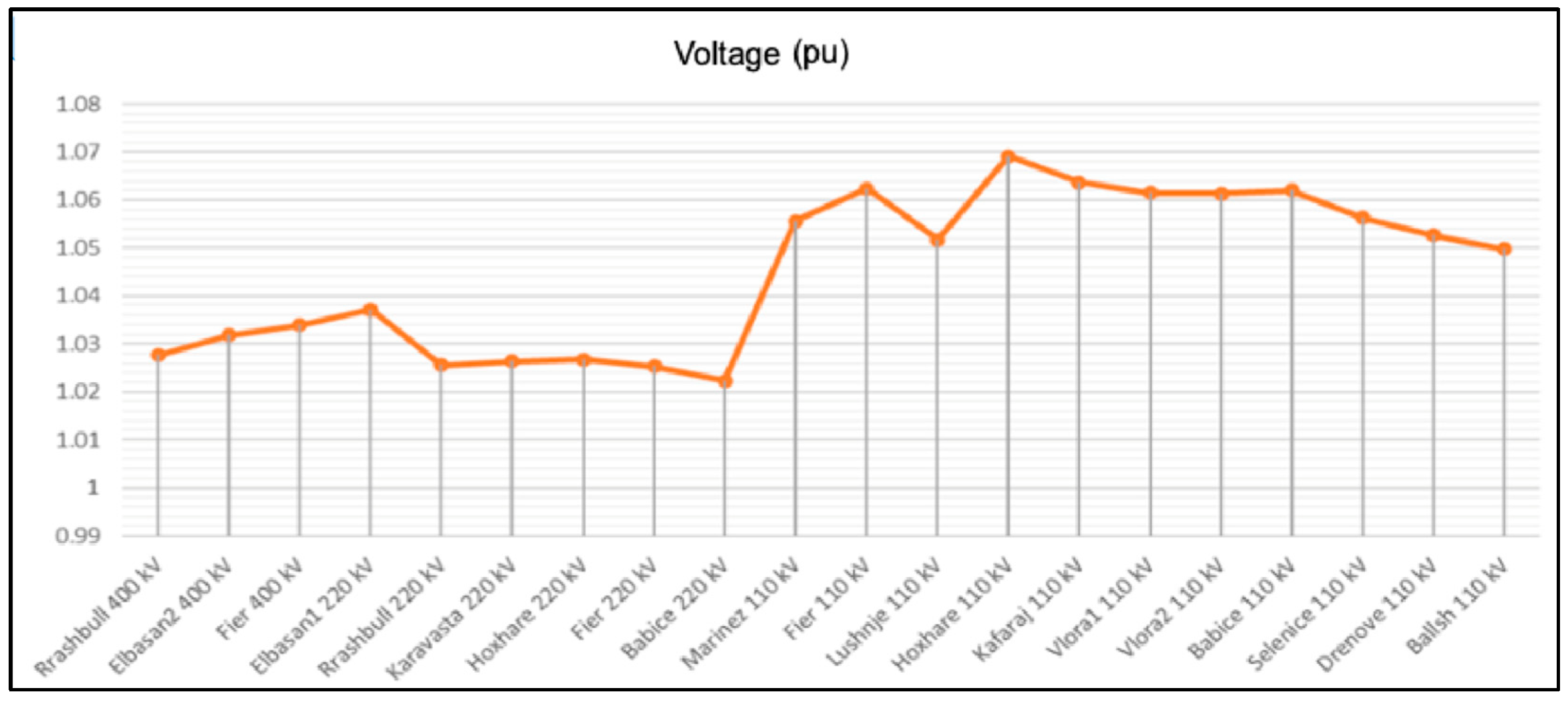
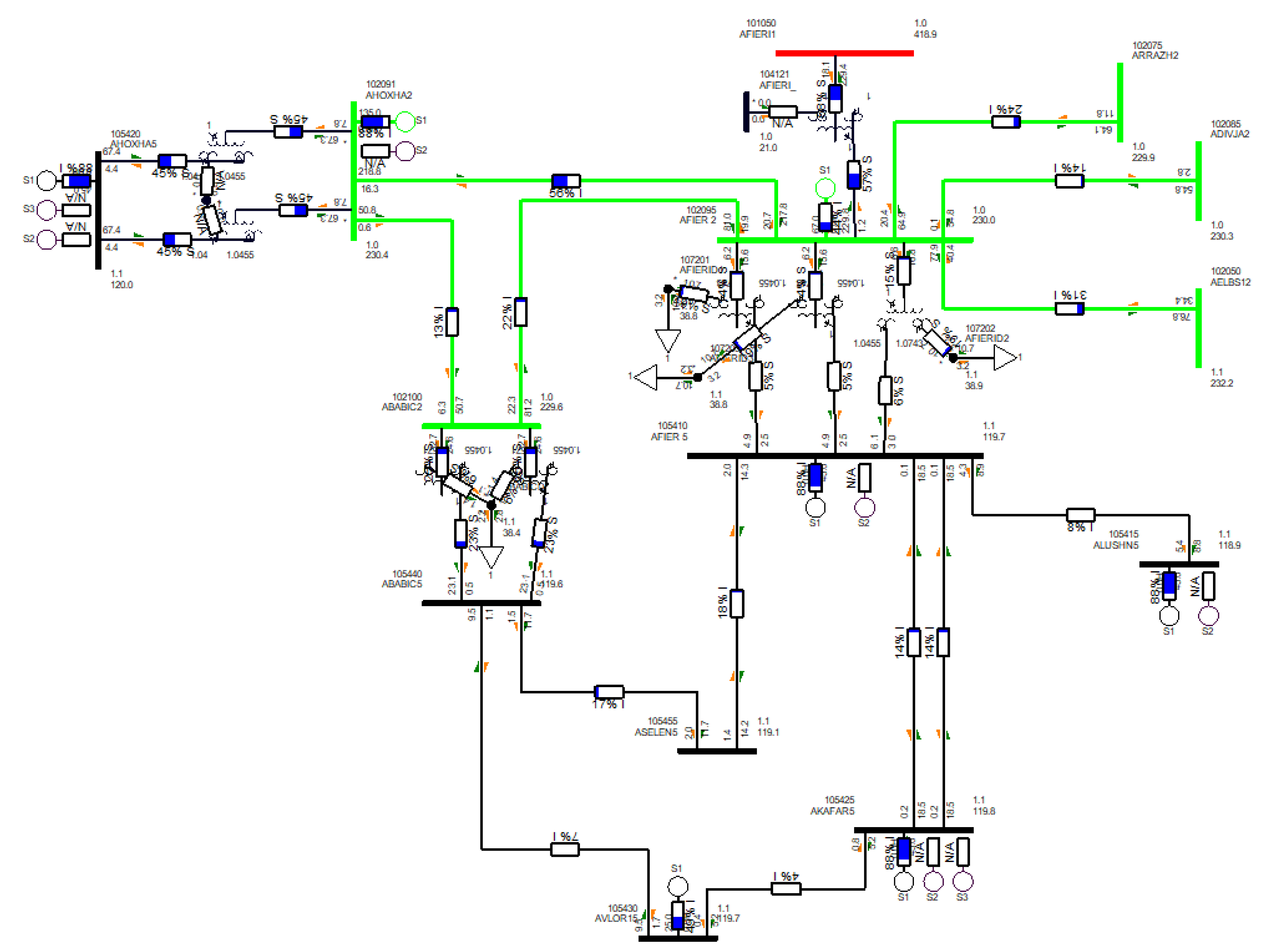
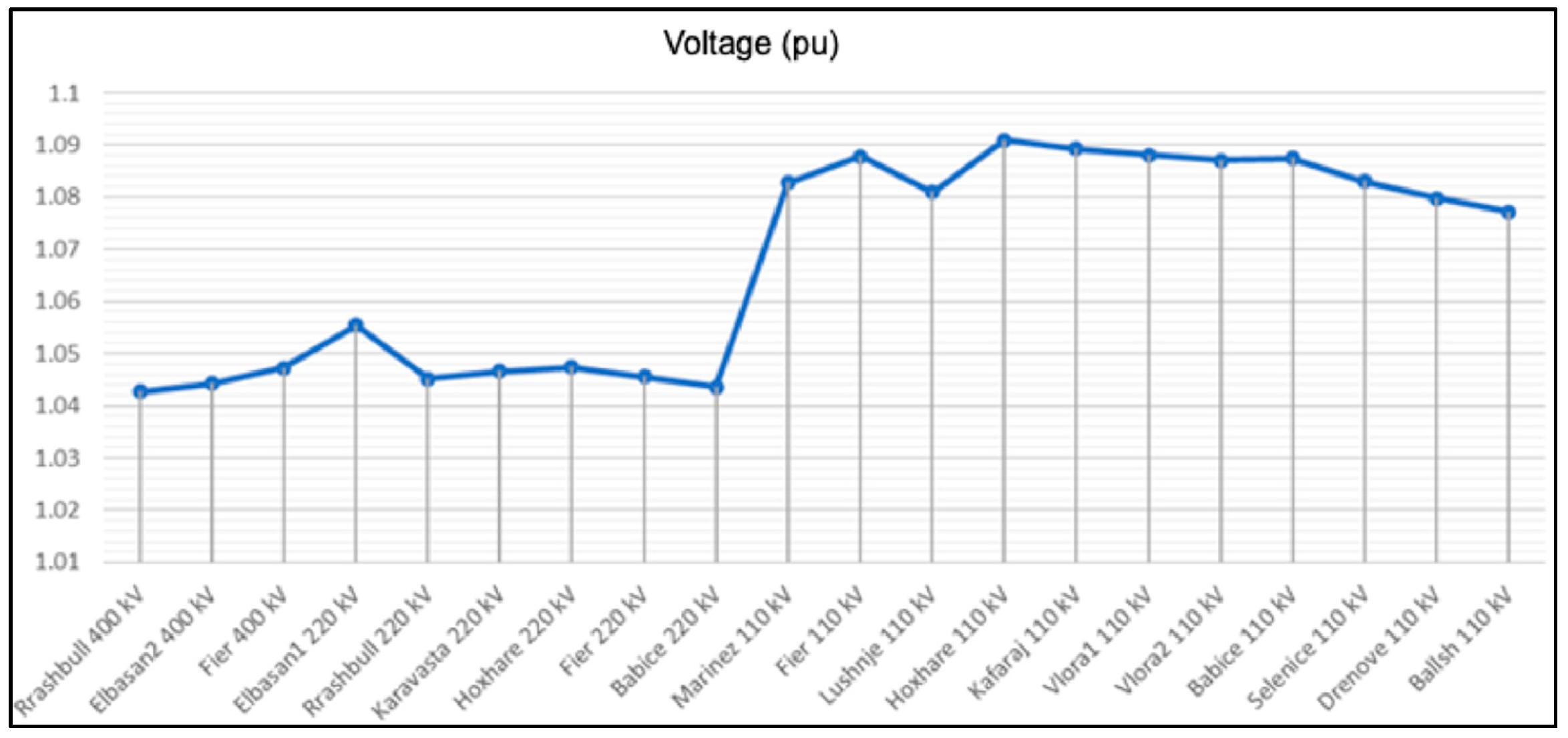

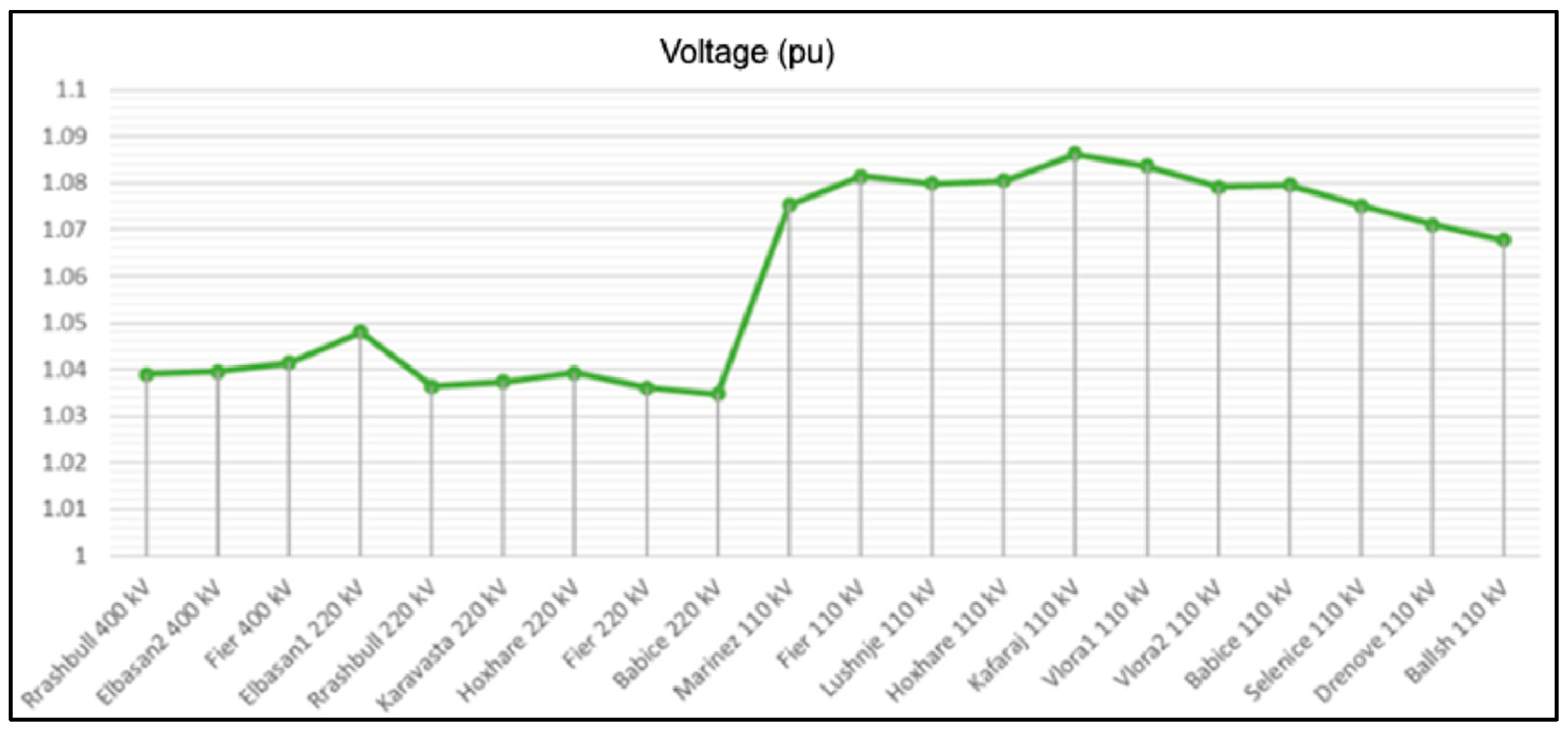
| Generation Type | Annual Energy Production [MWh] |
|---|---|
| PPE/hydropower connection to the DSO | 982,392 |
| PPE/hydropower connection to OST | 1,085,256 |
| Private hydropower connections to the OST | 1,204,759 |
| Lanabregas Hydropower Plant | 23,244 |
| Ashta Hydropower Plant | 287628 |
| Solar plant (with FTL contract) | 61,989 |
| Solar plant (with FTL contract) | 18,885 |
| Management of hydropower plants by KESH | 5,131,482 |
| Total | 8,795,635 |
| Months | Shkoder | Diber | Tirane | Fieri | Korça | Saranda |
|---|---|---|---|---|---|---|
| January | 1.70 | 1.55 | 1.80 | 2.15 | 1.90 | 1.90 |
| February | 2.30 | 2.30 | 2.50 | 2.85 | 2.70 | 2.40 |
| March | 3.35 | 3.25 | 3.40 | 3.90 | 3.40 | 3.60 |
| April | 4.50 | 4.15 | 4.20 | 5.00 | 4.40 | 4.80 |
| May | 5.45 | 5.25 | 5.55 | 6.05 | 5.60 | 5.80 |
| June | 6.10 | 5.85 | 6.40 | 6.80 | 6.40 | 6.80 |
| July | 6.50 | 6.25 | 6.70 | 7.20 | 6.80 | 6.10 |
| August | 5.55 | 5.45 | 6.05 | 6.40 | 5.90 | 4.80 |
| September | 4.45 | 4.35 | 4.70 | 5.15 | 4.70 | 3.60 |
| October | 2.90 | 2.90 | 3.20 | 3.50 | 3.10 | 3.20 |
| November | 2.10 | 1.85 | 2.15 | 2.40 | 2.10 | 2.10 |
| December | 1.70 | 1.50 | 1.75 | 1.85 | 1.80 | 1.80 |
| Solar Plant | Installed Capacity (MWp) |
|---|---|
| Volatile | 140 MWp |
| Akernia | 100 MWp |
| Solar System Nova | 70 MWp |
| Libohova Solar Plant | 93 MWp |
| Blue1 Solar Park | 57.6 MWp |
| Euron Solar Park | 150 MWp |
| Fier Solar Park | 175 MWp |
| TGH Solar Park | 18.39 MWp |
| Solar Plants | Installed Capacity (MWp) | Network Connection (kV) |
|---|---|---|
| Caravasta | 140 | 220 |
| Lushnje | 100 | 110 |
| Hoxhar 1 | 250 | 220 |
| Hoxhar 2 | 300 | 220 |
| Vlora 1 | 50 | 110 |
| Vlora 2 | 150 | 110 |
| Streaks | 100 | 110 |
| Fern 1 | 100 | 110 |
| Fern 2 | 150 | 110 |
| Belsh | 50 | 35 |
| Total | 1390 |
Disclaimer/Publisher’s Note: The statements, opinions and data contained in all publications are solely those of the individual author(s) and contributor(s) and not of MDPI and/or the editor(s). MDPI and/or the editor(s) disclaim responsibility for any injury to people or property resulting from any ideas, methods, instructions or products referred to in the content. |
© 2025 by the authors. Licensee MDPI, Basel, Switzerland. This article is an open access article distributed under the terms and conditions of the Creative Commons Attribution (CC BY) license (https://creativecommons.org/licenses/by/4.0/).
Share and Cite
Bardhi, A.; Eski, A.; Leka, B.; Dhoska, K. The Impact of Solar Power Plants on the Electricity Grid: A Case Study of Albania. Eng 2025, 6, 35. https://doi.org/10.3390/eng6020035
Bardhi A, Eski A, Leka B, Dhoska K. The Impact of Solar Power Plants on the Electricity Grid: A Case Study of Albania. Eng. 2025; 6(2):35. https://doi.org/10.3390/eng6020035
Chicago/Turabian StyleBardhi, Astrit, Ajakida Eski, Bajram Leka, and Klodian Dhoska. 2025. "The Impact of Solar Power Plants on the Electricity Grid: A Case Study of Albania" Eng 6, no. 2: 35. https://doi.org/10.3390/eng6020035
APA StyleBardhi, A., Eski, A., Leka, B., & Dhoska, K. (2025). The Impact of Solar Power Plants on the Electricity Grid: A Case Study of Albania. Eng, 6(2), 35. https://doi.org/10.3390/eng6020035







